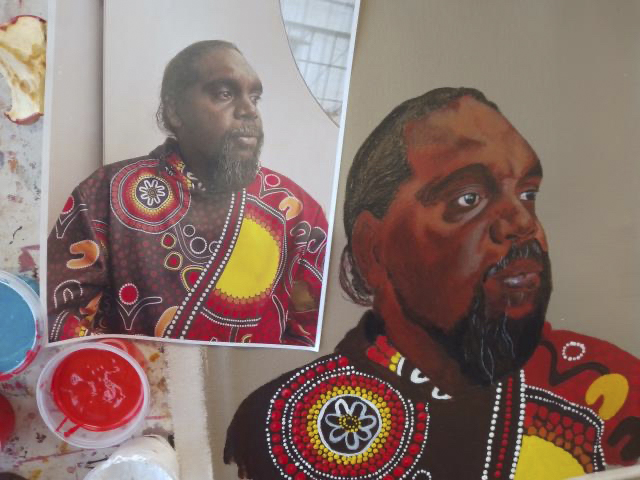Owen Biljabu is a direct descendent of several of Martumili Artist’s most eminent artists, including his grandmothers Jakayu Biljabu (dec.), Jugarda Dulcie Gibbs (dec.), Muni Rita Simpson (dec.), and Muntararr Rosie Williams (dec.). Chatting with him, he makes frequent heartfelt attributions to the enormous influence these women have had on his artistic career, crystalising the inextricable link between his boundless love of art and the support of these Martu matriarchs; “I always tell people how I learned. I tell them the story of my grandmothers. If it weren’t for them, I wouldn’t paint. They lifted my feelings up, and I knew they wanted me to do something with my life. That got me into art."
With Biljabu’s recent works his artistic prominence has quickly escalated, nurtured equally by his undeniable talent, passion, and determination. At the same time, he joins ranks with the empowered young men and women that are emerging as the new Martu cultural leaders.

A printed reference photograph of Martumili artist Owen Biljabu next to a painted self-portrait, 2020
How do you like your tea?
I drink it brown with one sugar, just tea. Bushells!
Can you tell us a bit about your early history?
I was born in Newman, and my mother took me to Jigalong when I was a newborn baby. I grew up with my cousin and other families. We moved to Parnngurr, then all the Martu communities. I got family in Parnngurr, Punmu, Jigalong and Kunawarritji. I was moving around a bit between them, and I went to Punmu school.
I was going up and down between the communities, but I moved back to Jigalong ‘cause that’s where my feelings are, where I wanna be. I feel at home there. I live there with my mother, Peggy [Gibbs], and my partner and kids.
How did you start painting?
When I first started, Martumili was starting up and my nannas, four of them [the late Jakayu Biljabu, Jugarda Dulcie Gibbs, Muni Rita Simpson, and Muntararr Rosie Williams], we started together. I did a portrait, sort of funny face. It didn’t look like anyone; I was just starting to paint. I showed them my painting and they was happy, supporting me even though it was a funny art. They was building something inside me like a good feeling for painting. They were like; “You’re doing a good painting, keep it up”, and that’s when I got a good feeling. I always tell people how I learned. I tell them the story of my grandmothers. If it weren’t for them, I wouldn’t paint. They lifted my feelings up, and I knew they wanted me to do something with my life. That got me into art.
I taught myself after that. On that day I tried it, that portrait, I fell in love with art. I’d go back to the house, and I had my own things, paint brushes and all, and I’d paint from memory. I was making landscapes in my head and painting it. Now I look around at peoples’ faces without them knowing about it, looking at the shape of their faces, their noses. I use photographs and memories.
What motivates you to paint?
Someone showed me long, long time ago when I was a kid an Albert Namatjira painting. I was looking at this man, thinking he done a really good job, done a realistic painting, and I thought maybe one day I can do something like that. I started trying to do landscape painting, but I wanted to do something different. Martu people in my tribe don’t do portraits, but I had a feeling that I wanted to be a famous portrait painter.
What’s the most important thing to you when you paint someone?
I try to give the person’s story. I try to get them to really look like them, how they normally act. I asked them, some people [if I could paint their portrait], but most people now, once they saw my painting, they want to get me to paint them. I didn’t have that before. They used to say no, but now more and more people are sending me pictures to paint. That’s more supporting for me, that’s lifting my feeling up. I gotta keep doing it ‘till I make something.
How do you feel when you paint?
These days people really respect my art. Makes me feel good to get respect for what I’ve created with my own hands. A couple of years ago I tried Revealed exhibition [New and Emerging WA Aboriginal Artists], painting with Spinifex Hill Artists. I entered a few competitions but nothing yet. When I put my art up on Facebook, lots of people are sharing it. I was excited to see how much ‘likes’ I get. Lot of people like my painting, especially Martu. What matters most to me is Martu people, ‘cause I’m a Martu person myself. If I can make Martu people happy and show them that we can do something with our lives, that’s the most important thing. Sometimes I put a message like “If I can do it you can do it too!” I don’t want to be better than anyone, I just want to do the best I can.
You began painting with your relatives. Is it important for you to paint with your children?
I try and teach my kids, three of them. I want them to follow my footstep. They really happy for me, but sometimes when I try to show them how to paint they shout at me; “Nah we’re doing it!” [Laughs]. My daughter, Oweesha, she’s good at painting now.
What are some of the other things you love to do?
I tried other things, like welding and all that, maybe I want to make a statue! Art is my thing, that’s my passion. I play music too, singing and writing songs for Wild Dingo Band.
